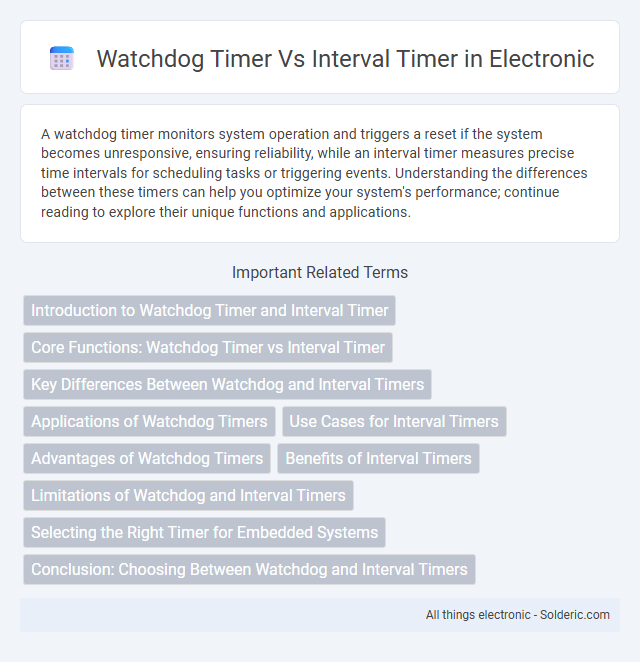A watchdog timer monitors system operation and triggers a reset if the system becomes unresponsive, ensuring reliability, while an interval timer measures precise time intervals for scheduling tasks or triggering events. Understanding the differences between these timers can help you optimize your system's performance; continue reading to explore their unique functions and applications.
Comparison Table
| Feature | Watchdog Timer | Interval Timer |
|---|---|---|
| Purpose | Monitors system for malfunction; triggers reset on failure | Generates periodic interrupts for timing and scheduling |
| Function | Resets system if software hangs or crashes | Measures time intervals or delays |
| Operation | Counts down continuously; requires regular refresh | Counts down or up; triggers event on expiry |
| Use Case | System reliability and fault detection | Task scheduling, periodic operations |
| Typical Timeout | Short, seconds or milliseconds | Varies widely, microseconds to minutes |
| Reset Capability | Yes, system reset on timeout | No reset capability |
| Example Application | Embedded systems watchdog for crash recovery | RTC alarms, timer interrupts in OS kernels |
Introduction to Watchdog Timer and Interval Timer
A watchdog timer is a hardware timer designed to detect and recover from system malfunctions by resetting the device if software fails to operate correctly within a specified time frame. An interval timer generates periodic interrupts at fixed intervals, enabling precise time-based task scheduling in embedded systems. Choosing the right timer depends on whether your application requires fault detection and system recovery or regular timing and event triggering.
Core Functions: Watchdog Timer vs Interval Timer
Watchdog timers primarily serve as fail-safe mechanisms that reset the system if software malfunctions or hangs, ensuring system reliability by monitoring operational status and triggering resets upon timeout. Interval timers function by generating precise, periodic interrupts to facilitate task scheduling, timekeeping, or event counting within embedded and real-time systems. Unlike interval timers, which focus on time-based event management, watchdog timers concentrate on system health monitoring and automatic recovery from failures.
Key Differences Between Watchdog and Interval Timers
Watchdog timers are specialized hardware timers designed to reset a system automatically if it becomes unresponsive, enhancing system reliability and preventing crashes. Interval timers, on the other hand, generate regular interrupts at specified time intervals for task scheduling or time measurement without triggering system resets. Unlike interval timers that support periodic operations, watchdog timers emphasize system fault detection and recovery through enforced timeout mechanisms.
Applications of Watchdog Timers
Watchdog timers are essential for embedded systems and critical applications requiring continuous monitoring to detect and recover from system failures. They automatically reset the system when software malfunctions, making them ideal for medical devices, automotive safety systems, and industrial automation. Your system's reliability and uptime significantly improve by integrating a watchdog timer to ensure fault tolerance and prevent potential system hangs.
Use Cases for Interval Timers
Interval timers are essential in applications requiring precise periodic task execution, such as embedded systems managing sensor data collection or real-time operating systems scheduling. They enable timely events like monitoring system health, triggering periodic updates, and executing time-critical processes at regular intervals. Unlike watchdog timers that reset systems upon failure, interval timers focus on consistent task timing and synchronization.
Advantages of Watchdog Timers
Watchdog timers enhance system reliability by automatically resetting devices during software malfunctions or freezes, reducing downtime and preventing system crashes. They offer a crucial safeguard in embedded systems and real-time applications by monitoring operational status and triggering recovery actions without external intervention. Their simplicity and low power consumption make them ideal for critical applications where continuous operation and fault tolerance are essential.
Benefits of Interval Timers
Interval timers provide precise timing control for executing tasks at regular intervals, improving system responsiveness and efficiency. They help in scheduling repetitive processes, reducing CPU idle time and ensuring timely task execution. This leads to enhanced performance in real-time applications and better resource management compared to watchdog timers.
Limitations of Watchdog and Interval Timers
Watchdog timers have limitations such as fixed timeout intervals that may not accommodate variable task execution times, potentially causing unintended system resets during legitimate delays. Interval timers lack the ability to detect system hangs or failures, as they only trigger events at predefined intervals without monitoring system responsiveness. Both types of timers require careful configuration to avoid false positives or missed fault detections in critical embedded systems.
Selecting the Right Timer for Embedded Systems
Selecting the right timer for embedded systems depends on your specific application needs; watchdog timers provide critical system reliability by resetting the system during software failures, ensuring continuous operation. Interval timers are ideal for precise event scheduling and periodic task execution, allowing you to manage timing with fine granularity. Understanding the difference between watchdog and interval timers helps optimize system performance and maintain stability in embedded designs.
Conclusion: Choosing Between Watchdog and Interval Timers
Watchdog timers are essential for system reliability, automatically resetting your device during software malfunctions, while interval timers excel at triggering precise, periodic tasks in embedded systems. Your choice depends on whether system fault recovery or timed event execution is the primary requirement. Combining both timers can enhance system robustness and functionality by addressing distinct operational needs.
watchdog timer vs interval timer Infographic

 solderic.com
solderic.com